Optimization of Hemicellulosic Carbohydrate Extraction from Corncobs via Hydrothermal Treatment: A Response Surface Methodology Approach
Abstract
1. Introduction
2. Materials and Methods
2.1. Chemicals
2.2. Materials
2.3. Design of Experiment—Optimization of the Pretreatment Parameters
2.4. Extraction of Hemicellulosic Sugars by Hydrothermal Pretreatment
2.5. Acid Hydrolysis of Hydrolysate Oligomers and Sugar Analysis
3. Results
3.1. Chemical Composition of Corncob
3.2. Optimization of the Pretreatment Conditions
3.3. Acid Hydrolysis of Hydrolysate Oligomers
3.4. Optimization of Xylose Yield Using RSM
4. Discussion
4.1. Optimization of the Pretreatment Conditions
4.2. Acid Hydrolysis of Oligomers
4.3. RSM Analysis of Sugar Yields
4.4. Optimization of Xylose Yield by BBD
4.5. Optimization of Total Sugars by BBD
5. Conclusions
Supplementary Materials
Author Contributions
Funding
Institutional Review Board Statement
Informed Consent Statement
Data Availability Statement
Acknowledgments
Conflicts of Interest
References
- Antonopoulou, G.; Papadopoulou, K.; Alexandropoulou, M.; Lyberatos, G. Liquid hot water treatment of woody biomass at different temperatures: The effect on composition and energy production in the form of gaseous biofuels. Sustain. Chem. Pharm. 2024, 38, 101485. [Google Scholar] [CrossRef]
- Cavailles, J.; Vaca-Medina, G.; Wu-Tiu-Yen, J.; Labonne, L.; Evon, P.; Peydecastaing, J.; Pontalier, P.-Y. Aqueous Pretreatment of Lignocellulosic Biomass for Binderless Material Production: Influence of Twin-Screw Extrusion Configuration and Liquid-to-Solid Ratio. Molecules 2024, 29, 3020. [Google Scholar] [CrossRef] [PubMed]
- Pelaez-Samaniego, M.R.; Mood, S.H.; Cisneros, J.F.; Fajardo-Seminario, J.; Yadama, V.; Garcia-Perez, T. Aqueous byproducts from biomass wet thermochemical processing: Valorization into fuels, chemicals, fertilizers, and biomaterials. Energy Convers. Manag. 2024, 307, 118360. [Google Scholar] [CrossRef]
- Zhang, H.; Hou, L.; Zhang, W.; Lin, Y.; Liu, X.; Zhao, S.; Chang, C. Coupling process for preparing biomass-based furfural and levulinic acid from corncob: Extraction, green chemistry and techno-economic assessment. Bioresour. Technol. 2024, 394, 130301. [Google Scholar] [CrossRef]
- Wang, J.-X.; Wang, D.-M.; Xu, W.-L.; Zou, X.-J.; Zong, P.-J.; Zhang, H.-Z.; Shang, Y.-C.; Zhao, J.-L.; Wu, Y.-F.; Qiao, Y.-Y. Study on the hydrothermal gradient extraction of hemicellulose by a flow-through reactor. J. Energy Inst. 2024, 117, 101855. [Google Scholar] [CrossRef]
- Imman, S.; Laosiripojana, N.; Champreda, V. Effects of liquid hot water pretreatment on enzymatic hydrolysis and physicochemical changes of corncobs. Appl. Biochem. Biotechnol. 2018, 184, 432–443. [Google Scholar] [CrossRef]
- Xiao, L.-P.; Sun, Z.-J.; Shi, Z.-J.; Xu, F.; Sun, R.-C. Impact of hot compressed water pretreatment on the structural changes of woody biomass for bioethanol production. BioResources 2011, 6, 1576–1598. [Google Scholar] [CrossRef]
- Vallejos, M.E.; Felissia, F.E.; Kruyeniski, J.; Area, M.C. Kinetic study of the extraction of hemicellulosic carbohydrates from sugarcane bagasse by hot water treatment. Ind. Crops Prod. 2015, 67, 1–6. [Google Scholar] [CrossRef]
- Liu, C.; Wyman, C.E. Partial flow of compressed-hot water through corn stover to enhance hemicellulose sugar recovery and enzymatic digestibility of cellulose. Bioresour. Technol. 2005, 96, 1978–1985. [Google Scholar] [CrossRef]
- Santos, T.M.; Alonso, M.V.; Oliet, M.; Domínguez, J.C.; Rigual, V.; Rodriguez, F. Effect of autohydrolysis on Pinus radiata wood for hemicellulose extraction. Carbohydr. Polym. 2018, 194, 285–293. [Google Scholar] [CrossRef]
- Wells, J.M.; Drielak, E.; Surendra, K.; Khanal, S.K. Hot water pretreatment of lignocellulosic biomass: Modeling the effects of temperature, enzyme and biomass loadings on sugar yield. Bioresour. Technol. 2020, 300, 122593. [Google Scholar] [CrossRef]
- Sukhbaatar, B.; Kim, M.; Steele, P.; Ingram, L. Optimization of hot-compressed water pretreatment of bagasse and characterization of extracted hemicelluloses. Carbohydr. Polym. 2014, 101, 196–202. [Google Scholar] [CrossRef] [PubMed]
- Nitsos, C.K.; Choli-Papadopoulou, T.; Matis, K.A.; Triantafyllidis, K.S. Optimization of hydrothermal pretreatment of hardwood and softwood lignocellulosic residues for selective hemicellulose recovery and improved cellulose enzymatic hydrolysis. ACS Sustain. Chem. Eng. 2016, 4, 4529–4544. [Google Scholar] [CrossRef]
- Čolnik, M.; Irgolič, M.; Perva, A.; Škerget, M. Hydrolytic Decomposition of Corncobs to Sugars and Derivatives Using Subcritical Water. Processes 2025, 13, 267. [Google Scholar] [CrossRef]
- Yu, Y.; Long, Y.; Wu, H. Near-complete recovery of sugar monomers from cellulose and lignocellulosic biomass via a two-step process combining mechanochemical hydrolysis and dilute acid hydrolysis. Energy Fuels 2016, 30, 1571–1578. [Google Scholar] [CrossRef]
- Rivas, S.; González-Muñoz, M.J.; Santos, V.; Parajó, J.C. Acidic processing of hemicellulosic saccharides from pine wood: Product distribution and kinetic modeling. Bioresour. Technol. 2014, 162, 192–199. [Google Scholar] [CrossRef]
- Nakasu, P.; Ienczak, L.; Costa, A.; Rabelo, S. Acid post-hydrolysis of xylooligosaccharides from hydrothermal pretreatment for pentose ethanol production. Fuel 2016, 185, 73–84. [Google Scholar] [CrossRef]
- Li, H.; Deng, A.; Ren, J.; Liu, C.; Lu, Q.; Zhong, L.; Peng, F.; Sun, R. Catalytic hydrothermal pretreatment of corncob into xylose and furfural via solid acid catalyst. Bioresour. Technol. 2014, 158, 313–320. [Google Scholar] [CrossRef]
- Okeke, F.O.; Ahmed, A.; Imam, A.; Hassanin, H. A review of corncob-based building materials as a sustainable solution for the building and construction industry. Hybrid Adv. 2024, 6, 100269. [Google Scholar] [CrossRef]
- Wang, J.; Hu, X. Research on corn production efficiency and influencing factors of typical farms: Based on data from 12 corn-producing countries from 2012 to 2019. PLoS ONE 2021, 16, e0254423. [Google Scholar] [CrossRef]
- Erickson, M.J.; Dobbins, C.; Tyner, W.E. The economics of harvesting corn cobs for energy. Crop Manag. 2011, 10, 1–8. [Google Scholar] [CrossRef][Green Version]
- Phojaroen, J.; Jiradechakorn, T.; Kirdponpattara, S.; Sriariyanun, M.; Junthip, J.; Chuetor, S. Performance Evaluation of Combined Hydrothermal-Mechanical Pretreatment of Lignocellulosic Biomass for Enzymatic Enhancement. Polymers 2022, 14, 2313. [Google Scholar] [CrossRef] [PubMed]
- Cardoso, C.E.; Almeida, J.C.; Rocha, J.; Pereira, E. Application of Box-Behnken design to optimize the phosphorus removal from industrial wastewaters using magnetic nanoparticles. Environ. Sci. Pollut. Res. 2025, 32, 6804–6816. [Google Scholar] [CrossRef]
- Chen, C.; Luo, Z.; Tu, H.; Lin, X.; Pang, Y.; Huang, J.; Zhang, J.; Wang, X.; Cai, Q.; Wei, Z. Response surface methodology and Box-Behnken design optimization of Sulfaquinoxaline removal efficiency and degradation mechanisms by Bacillus sp. strain DLY-11. J. Hazard. Mater. 2025, 486, 136986. [Google Scholar] [CrossRef]
- Sluiter, A.; Hames, B.; Ruiz, R.; Scarlata, C.; Sluiter, J.; Templeton, D.; Crocker, D. Determination of structural carbohydrates and lignin in biomass. Lab. Anal. Proced. 2008, 1617, 1–16. [Google Scholar]
- Witek-Krowiak, A.; Chojnacka, K.; Podstawczyk, D.; Dawiec, A.; Bubała, K. Application of response surface methodology and artificial neural network methods in modelling and optimization of biosorption process. Bioresour. Technol. 2014, 160, 150–160. [Google Scholar] [CrossRef] [PubMed]
- Wang, E.; Ballachay, R.; Cai, G.; Cao, Y.; Trajano, H.L. Predicting xylose yield from prehydrolysis of hardwoods: A machine learning approach. Front. Chem. Eng. 2022, 4, 994428. [Google Scholar] [CrossRef]
- Zhou, Q.; Ding, A.; Zhang, L.; Wang, J.; Gu, J.; Wu, T.Y.; Gu, X.; Zhang, L. Furfural production from the lignocellulosic agro-forestry waste by solvolysis method—A technical review. Fuel Process. Technol. 2024, 255, 108063. [Google Scholar] [CrossRef]
- Ji, X.; Ma, H.; Tian, Z.; Lyu, G.; Fang, G.; Chen, J.; Saeed, H.A. Production of xylose from diluted sulfuric acid hydrolysis of wheat straw. BioResources 2017, 12, 7084–7095. [Google Scholar] [CrossRef]
- Wong, L.J.; San H’ng, P.; Abdullah, L.C.; Paridah, M.T.; Chin, K.L. Effect of Chemical Steeping on Yields of Glucose and Xylose from Dilute Acid Hydrolysis of Extract from Oil Palm Trunk. BioResources 2022, 17, 207–222. [Google Scholar] [CrossRef]
- Xu, Q.; Yang, W.; Liu, G.; Liang, C.; Lu, S.; Qi, Z.; Hu, J.; Wang, Q.; Qi, W. Enhanced enzymatic hydrolysis of corncob by synthesized enzyme-mimetic magnetic solid acid pretreatment in an aqueous phase. ACS Omega 2019, 4, 17864–17873. [Google Scholar] [CrossRef] [PubMed]
- Lu, S.; Wang, Q.; Wang, X.; Liang, C.; Fu, J.; Xu, Z.; Wang, Z.; Yuan, Z.; Yue, J.; Qi, W. Preparation of reducing sugars from corncob by solid acid catalytic pretreatment combined with in situ enzymatic hydrolysis. Biomass Convers. Biorefin. 2021, 13, 12619–12629. [Google Scholar] [CrossRef]
- Kootstra, A.M.J.; Mosier, N.S.; Scott, E.L.; Beeftink, H.H.; Sanders, J.P. Differential effects of mineral and organic acids on the kinetics of arabinose degradation under lignocellulose pretreatment conditions. Biochem. Eng. J. 2009, 43, 92–97. [Google Scholar] [CrossRef]
- Wang, Z.; Chi, X.; Feng, H.; Yao, X.; Bi, Y.; Yang, R.; Li, B. Potassium Hydroxide-Mediated Pretreatment of Sugarcane Bagasse: High-Efficiency Enzymatic Hydrolysis and Excellent Sugar Recovery. Appl. Biochem. Biotechnol. 2025, 197, 3907–3928. [Google Scholar] [CrossRef]
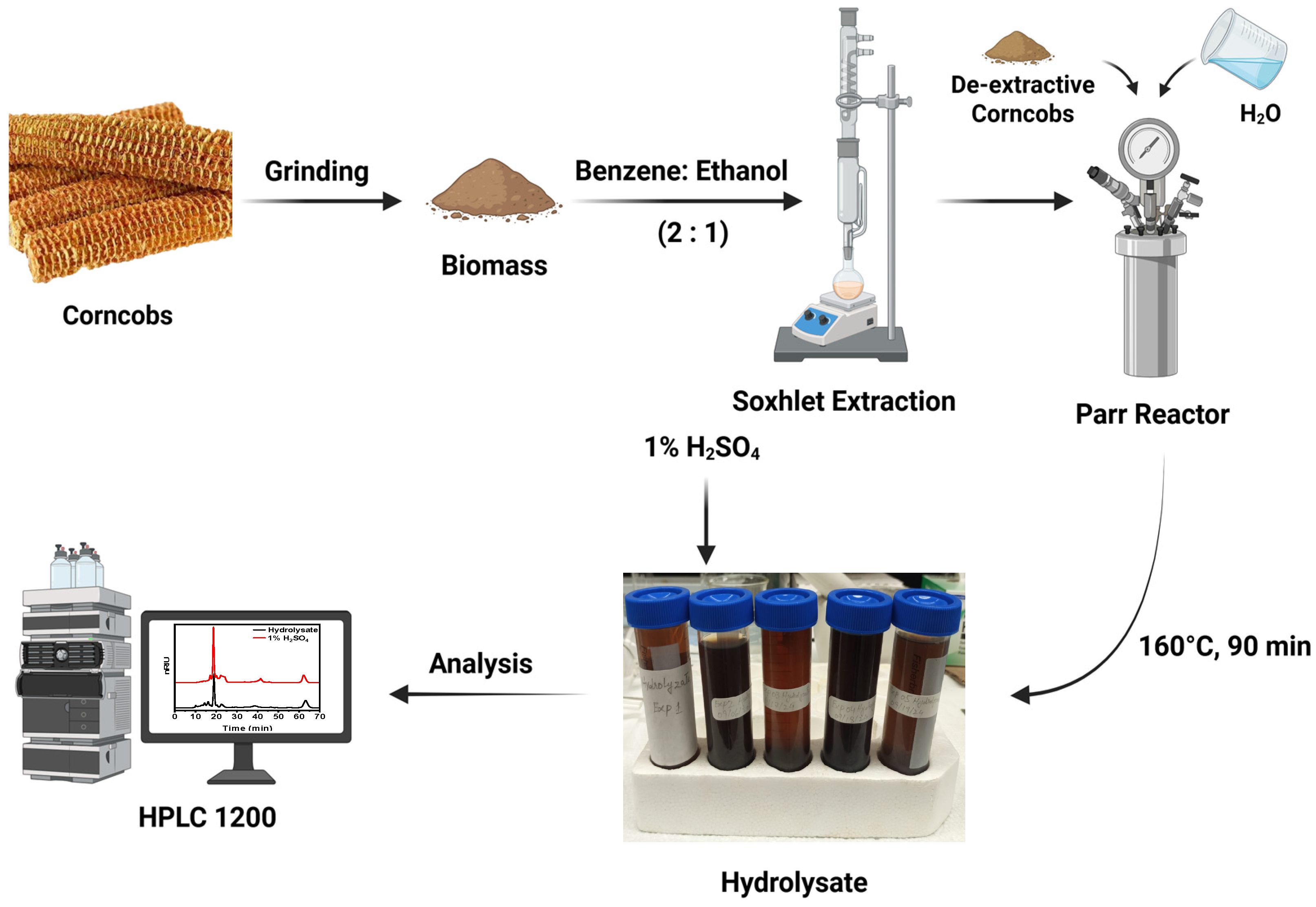
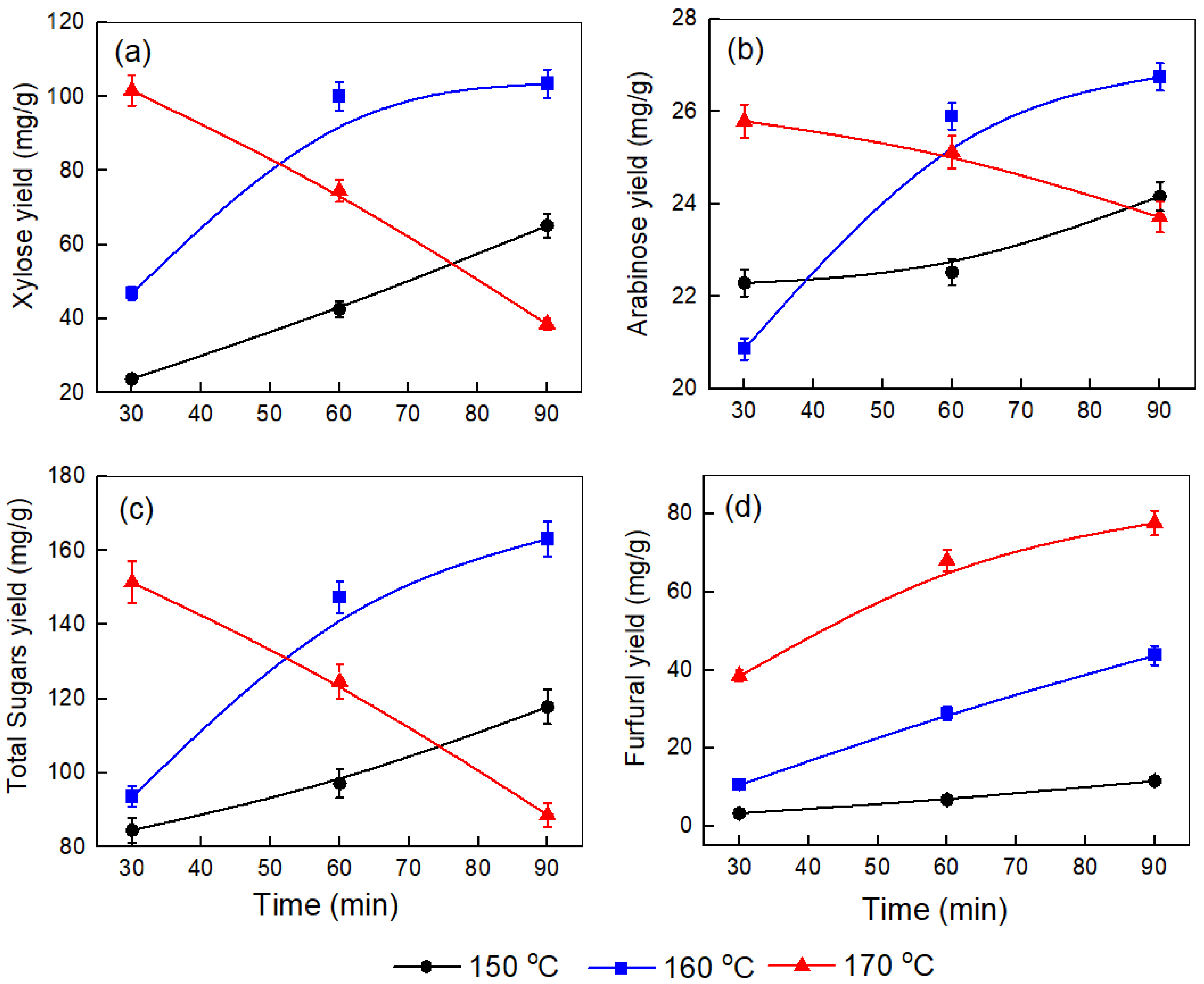
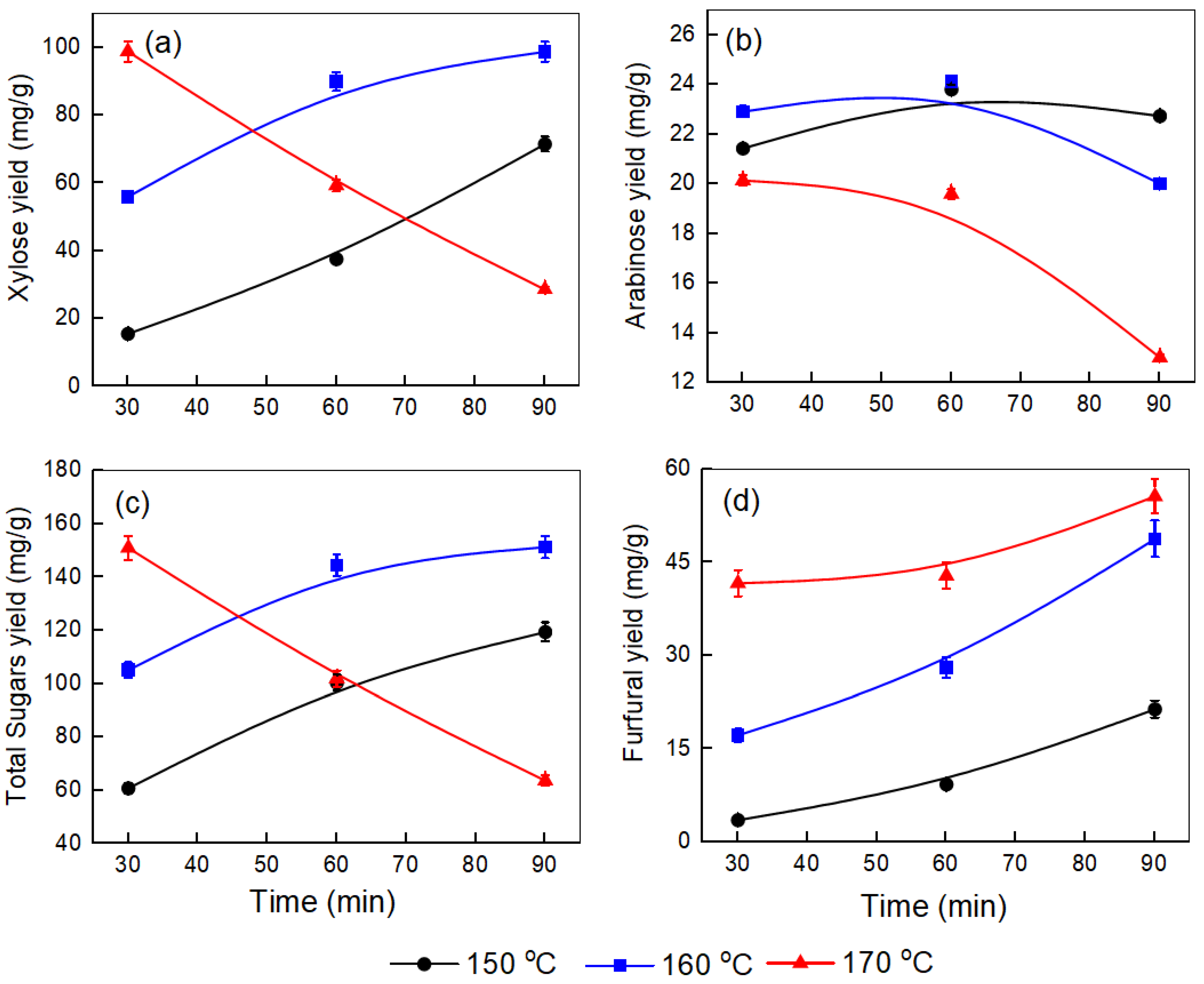
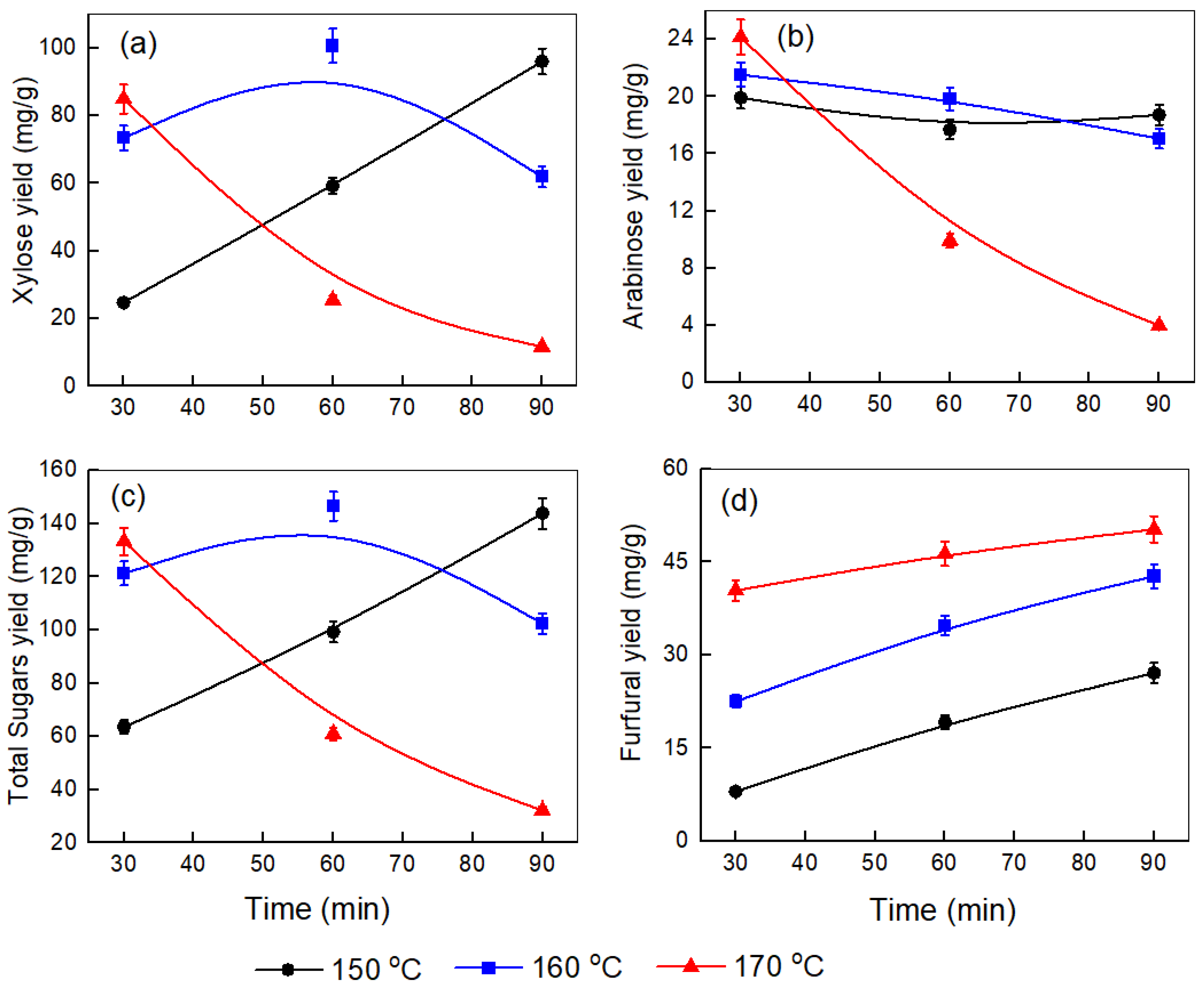
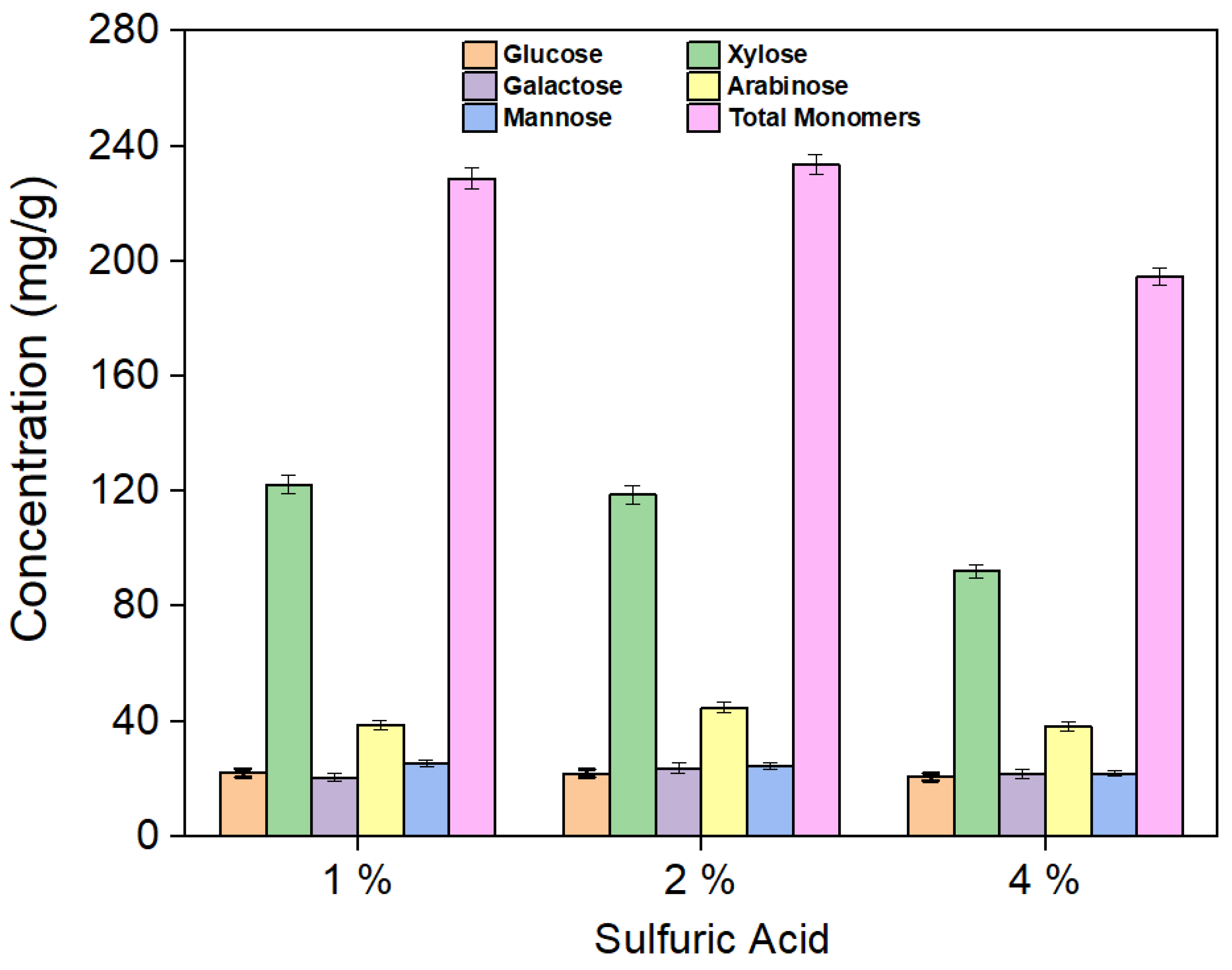
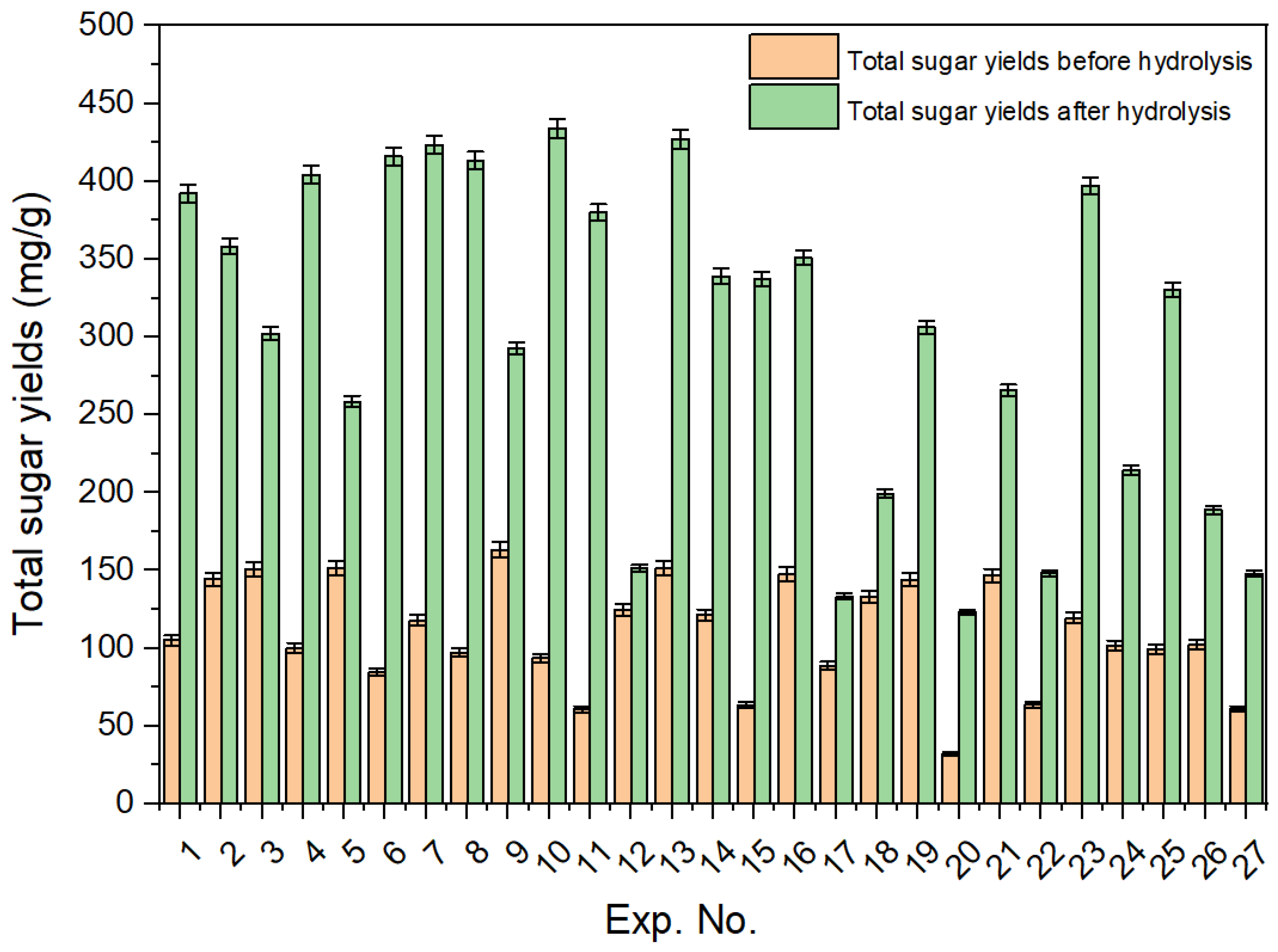

| Factors | Unit | Symbol | Levels in Box–Behnken Design | ||
|---|---|---|---|---|---|
| Low (−1) | Medium (0) | High (+1) | |||
| Temperature | °C | T | 150 | 160 | 170 |
| Time | min | M | 30 | 60 | 90 |
| Corncob-to-water ratio | ratio | R | 0.5:10 | 1:10 | 1.5:10 |
| Exp. No. | Corncob-to-Water Ratio | Temp (°C) | Time (min) | Exp. No. | Corncob-to-Water Ratio | Temp (°C) | Time (min) |
|---|---|---|---|---|---|---|---|
| 1 | 1:10 | 160 | 30 | 15 | 1.5:10 | 150 | 30 |
| 2 | 1:10 | 160 | 60 | 16 | 0.5:10 | 160 | 60 |
| 3 | 1:10 | 170 | 30 | 17 | 0.5:10 | 170 | 90 |
| 4 | 1:10 | 150 | 60 | 18 | 1.5:10 | 170 | 30 |
| 5 | 1:10 | 160 | 90 | 19 | 1.5:10 | 150 | 90 |
| 6 | 0.5:10 | 150 | 30 | 20 | 1.5:10 | 170 | 90 |
| 7 | 0.5:10 | 150 | 90 | 21 | 1.5:10 | 160 | 60 |
| 8 | 0.5:10 | 150 | 60 | 22 | 1:10 | 170 | 90 |
| 9 | 0.5:10 | 160 | 90 | 23 | 1:10 | 150 | 90 |
| 10 | 0.5:10 | 160 | 30 | 24 | 1:10 | 170 | 60 |
| 11 | 1:10 | 150 | 30 | 25 | 1.5:10 | 150 | 60 |
| 12 | 0.5:10 | 170 | 60 | 26 | 1.5:10 | 160 | 90 |
| 13 | 0.5:10 | 170 | 30 | 27 | 1.5:10 | 170 | 60 |
| 14 | 1.5:10 | 160 | 30 |
| (%) ± SD | |
|---|---|
| Glucose | 37.5 ± 0.90 |
| Xylose | 29.6 ± 0.86 |
| Galactose | 1.2 ± 0.04 |
| Arabinose | 10.5 ± 0.32 |
| Mannose | 3.6 ± 0.11 |
| Insoluble lignin | 11.2 ± 0.34 |
| Ash | 1.3 ± 0.04 |
| Extractives and others | 4.1 ± 0.12 |
| Total | 99.0 ± 2.71 |
| Std Order | T | M | R | Experimental Xylose Yield (mg/g) | Predicted Xylose Yield (mg/g) | Error |
|---|---|---|---|---|---|---|
| 1 | 150 | 30 | 1:10 | 15.52 | 14.48 | 1.03 |
| 2 | 170 | 30 | 1:10 | 82.78 | 81.40 | 1.38 |
| 3 | 150 | 90 | 1:10 | 89.17 | 90.55 | −1.38 |
| 4 | 170 | 90 | 1:10 | 28.52 | 29.56 | −1.03 |
| 5 | 150 | 60 | 0.5:10 | 39.59 | 40.11 | −0.52 |
| 6 | 170 | 60 | 0.5:10 | 74.61 | 75.49 | −0.87 |
| 7 | 150 | 60 | 1.5:10 | 59.26 | 58.39 | 0.87 |
| 8 | 170 | 60 | 1.5:10 | 29.46 | 28.93 | 0.52 |
| 9 | 160 | 30 | 0.5:10 | 56.90 | 57.41 | −0.51 |
| 10 | 160 | 90 | 0.5:10 | 103.49 | 101.58 | 1.91 |
| 11 | 160 | 30 | 1.5:10 | 73.43 | 75.33 | −1.91 |
| 12 | 160 | 90 | 1.5:10 | 55.89 | 55.39 | 0.51 |
| 13 | 160 | 60 | 1:10 | 89.89 | 89.89 | 5.50 × 10−15 |
| 14 | 160 | 60 | 1:10 | 89.89 | 89.89 | −1.24 × 10−14 |
| 15 | 160 | 60 | 1:10 | 89.89 | 89.89 | 4.11 × 10−15 |
| Source | DF | Sum of Squares | Mean Square | F-Value | Prob > F | Remarks |
|---|---|---|---|---|---|---|
| T | 1 | 17.53 | 17.53 | 5.54 | 0.07 | Not Significant |
| M | 1 | 293.39 | 293.39 | 92.69 | 2.05 × 10−4 | Highly Significant |
| R | 1 | 399.76 | 399.76 | 126.29 | 9.74 × 10−5 | Highly Significant |
| TT | 1 | 2833.83 | 2833.83 | 895.28 | 7.82 × 10−7 | Highly Significant |
| MM | 1 | 147.47 | 147.47 | 46.59 | 0.001 | Significant |
| RR | 1 | 396.83 | 396.83 | 125.37 | 9.92 × 10−5 | Highly Significant |
| TM | 1 | 4090.45 | 4090.45 | 1292.27 | 3.14 × 10−7 | Highly Significant |
| TR | 1 | 1050.70 | 1050.70 | 331.94 | 9.16 × 10−6 | Highly Significant |
| MR | 1 | 1027.91 | 1027.91 | 324.74 | 9.67 × 10−6 | Highly Significant |
| Error | 5 | 15.83 | 3.17 | |||
| Lack of Fit | 3 | 15.83 | 5.28 | 3.27 × 1028 | 3.05 × 10−29 | Highly Significant |
| Pure Error | 2 | 3.22 × 10−28 | 1.61 × 10−28 | |||
| Total | 14 | 10,273.71 | ||||
| R2 = 0.998 | Adj R2 = 0.995 | |||||
| Term | Value | Standard Error | 95% LCL | 95% UCL | T-Value | Prob > |t| |
|---|---|---|---|---|---|---|
| Intercept | 89.89 | 1.03 | 87.25 | 92.53 | 2.74 × 1016 | 1.33 × 10−33 |
| T | 1.48 | 0.63 | −0.14 | 3.10 | 4.52 × 1014 | 4.90 × 10−30 |
| M | 6.06 | 0.63 | 4.44 | 7.67 | 1.88 × 1015 | 2.93 × 10−31 |
| R | −7.07 | 0.63 | −8.69 | −5.45 | −2.16 × 1015 | 2.15 × 10−31 |
| TT | −28.80 | 0.93 | −31.18 | −26.42 | −8.79 × 1015 | 1.29 × 10−32 |
| MM | −7.10 | 0.93 | −9.48 | −4.72 | −2.17 × 1015 | 2.13 × 10−31 |
| RR | −10.37 | 0.93 | −12.75 | −7.99 | −3.16 × 1015 | 9.99 × 10−32 |
| TM | −31.98 | 0.89 | −34.27 | −29.69 | −9.76 × 1015 | 1.05 × 10−32 |
| TR | −16.21 | 0.89 | −18.49 | −13.92 | −4.95 × 1015 | 4.09 × 10−32 |
| MR | −16.03 | 0.89 | −18.32 | −13.74 | −4.89 × 1015 | 4.18 × 10−32 |
Disclaimer/Publisher’s Note: The statements, opinions and data contained in all publications are solely those of the individual author(s) and contributor(s) and not of MDPI and/or the editor(s). MDPI and/or the editor(s) disclaim responsibility for any injury to people or property resulting from any ideas, methods, instructions or products referred to in the content. |
© 2025 by the authors. Licensee MDPI, Basel, Switzerland. This article is an open access article distributed under the terms and conditions of the Creative Commons Attribution (CC BY) license (https://creativecommons.org/licenses/by/4.0/).
Share and Cite
Manzoor, M.H.; Elsayed, I.; Hassan, E.B. Optimization of Hemicellulosic Carbohydrate Extraction from Corncobs via Hydrothermal Treatment: A Response Surface Methodology Approach. Sustain. Chem. 2025, 6, 27. https://doi.org/10.3390/suschem6030027
Manzoor MH, Elsayed I, Hassan EB. Optimization of Hemicellulosic Carbohydrate Extraction from Corncobs via Hydrothermal Treatment: A Response Surface Methodology Approach. Sustainable Chemistry. 2025; 6(3):27. https://doi.org/10.3390/suschem6030027
Chicago/Turabian StyleManzoor, Muhammad Husnain, Islam Elsayed, and El Barbary Hassan. 2025. "Optimization of Hemicellulosic Carbohydrate Extraction from Corncobs via Hydrothermal Treatment: A Response Surface Methodology Approach" Sustainable Chemistry 6, no. 3: 27. https://doi.org/10.3390/suschem6030027
APA StyleManzoor, M. H., Elsayed, I., & Hassan, E. B. (2025). Optimization of Hemicellulosic Carbohydrate Extraction from Corncobs via Hydrothermal Treatment: A Response Surface Methodology Approach. Sustainable Chemistry, 6(3), 27. https://doi.org/10.3390/suschem6030027






